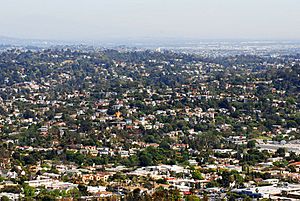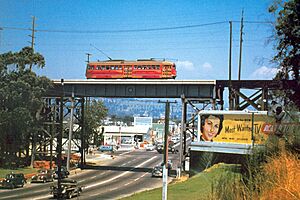Silver Lake, Los Angeles facts for kids
Quick facts for kids
Silver Lake
|
|
|---|---|
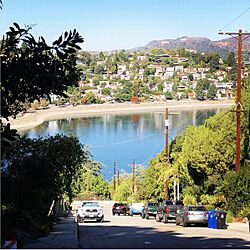
The hills of Silver Lake
|
|
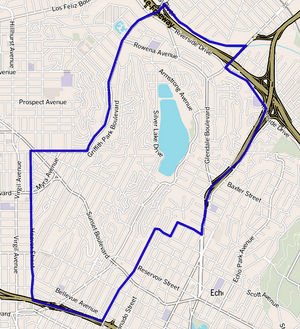
Silver Lake boundaries as drawn by the Los Angeles Times
|
|
| Country | United States |
| State | California |
| County | Los Angeles |
| City | Los Angeles |
| Named for | Politician Herman Silver |
| Elevation | 358 ft (109 m) |
| Time zone | UTC-8 (PST) |
| • Summer (DST) | UTC-7 (PDT) |
| Zip codes |
90026, 90039
|
| Area code(s) | 213, 323 |
Silver Lake is a lively neighborhood in the east-central part of Los Angeles, California. It started as a small community called Ivanhoe. This name came from a famous novel by Sir Walter Scott.
In 1907, the Los Angeles Department of Water and Power built the Silver Lake Reservoir. This reservoir was named after LA Water Commissioner Herman Silver. That's how the neighborhood got its name! Today, Silver Lake is famous for its unique homes, local shops, many restaurants, colorful painted staircases, and a creative vibe.
Contents
Geography and Climate in Silver Lake
Silver Lake is surrounded by several other Los Angeles neighborhoods. To the northeast, you'll find Atwater Village and Elysian Valley. Echo Park is to the southeast.
To the southwest is Westlake. East Hollywood is to the west, and Los Feliz is to the northwest. Major roads and natural features like the Los Angeles River help define its edges.
Moreno Highlands: A Special Area
A beautiful part of Silver Lake is called Moreno Highlands. It's located around the Silver Lake Reservoir. This area was developed in the 1920s and 1930s. Daisy Canfield, who was married to silent film star Antonio Moreno, helped create it. Many historic homes in Silver Lake are found here.
What's the Weather Like in Silver Lake?
Silver Lake has a mild and pleasant climate for most of the year. Summers are warm and sunny, while winters are cool but not freezing. It doesn't get much rain, especially in the summer months.
| Climate data for Silver Lake, Los Angeles | |||||||||||||
|---|---|---|---|---|---|---|---|---|---|---|---|---|---|
| Month | Jan | Feb | Mar | Apr | May | Jun | Jul | Aug | Sep | Oct | Nov | Dec | Year |
| Mean daily maximum °F (°C) | 67.5 (19.7) |
67.8 (19.9) |
69.2 (20.7) |
71.8 (22.1) |
73.5 (23.1) |
77.0 (25.0) |
81.9 (27.7) |
83.4 (28.6) |
82.3 (27.9) |
77.8 (25.4) |
72.2 (22.3) |
67.1 (19.5) |
74.3 (23.5) |
| Mean daily minimum °F (°C) | 47.9 (8.8) |
49.0 (9.4) |
50.6 (10.3) |
53.0 (11.7) |
56.6 (13.7) |
59.9 (15.5) |
63.3 (17.4) |
63.8 (17.7) |
62.5 (16.9) |
58.1 (14.5) |
52.0 (11.1) |
47.5 (8.6) |
55.4 (13.0) |
| Average precipitation inches (mm) | 3.64 (92) |
4.05 (103) |
3.44 (87) |
0.89 (23) |
0.35 (8.9) |
0.08 (2.0) |
0.02 (0.51) |
0.14 (3.6) |
0.35 (8.9) |
0.49 (12) |
1.23 (31) |
2.04 (52) |
16.72 (425) |
History of Silver Lake
The northern part of Silver Lake, once called Ivanhoe, was developed around 1887. Its name came from Sir Walter Scott's book Ivanhoe. Many streets in the area are also named after characters and places from British literature.
Early Transportation and the Red Car
In 1904, the Fletcher Drive Viaduct was built. This bridge helped the Pacific Electric Railway's "Red Car" trains connect the area to Downtown Los Angeles. The original wooden bridge was replaced with a steel one in 1928. It was taken down in 1959, but you can still see its concrete supports.
Building the Reservoirs
William Mulholland, a famous engineer, saw Silver Lake as a perfect spot for water reservoirs. These would supply water to the fast-growing city. The Ivanhoe Reservoir was built in 1906, and the Silver Lake Reservoir followed in 1907. The Silver Lake reservoir was named after Herman Silver. He was a city councilman and water commissioner who helped get the land and money for the project.
A Hub for Artists and Architects
Silver Lake has always attracted creative people. In the 1930s and 1940s, artists, writers, actors, and musicians moved to the area. They were joined by other forward-thinking people, like union organizers.
Many famous architects, such as Gregory Ain and John Lautner, designed homes and buildings here. This means Silver Lake has more unique and important architectural homes than many other parts of Los Angeles.
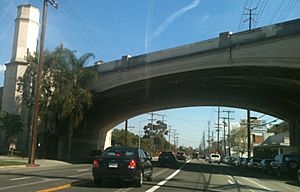
Silver Lake's Film Studio Past
The area near Silver Lake, especially Edendale, was a very early center for filmmaking. William Selig opened one of the first permanent film studios in Los Angeles in 1909. Mack Sennett followed in 1912.
Walt Disney's first studio was also in Silver Lake, at Griffith Park Boulevard and Hyperion Avenue. Because of this, the name "Hyperion" is still used by The Walt Disney Company for things like Hyperion Books and the Hyperion Theater at Disney California Adventure Park.
William Fox bought Selig's old studio lot in 1917. He built a large outdoor set called Mixville for the Western movie star Tom Mix. Today, this spot is a shopping center. People say that Tom Mix even buried his horse, "Old Blue," on the property!
Exploring Silver Lake's Staircases
Silver Lake is known for its many public staircases. These stairs help people walk up and down the neighborhood's hilly streets. Some famous ones include the Descanso Stairs and the Music Box Stairs. The funny movie The Music Box by Laurel and Hardy features a famous flight of stairs in Silver Lake.
Opening Doors for Everyone
In the 1940s, Chinese-American architect Eugene Kinn Choy wanted to build a house for his family in Silver Lake. At that time, some rules made it hard for people of certain backgrounds to buy property. Eugene Kinn Choy went door-to-door, asking every neighbor for their approval. He was finally able to build his home in 1949. His efforts helped open the neighborhood to Asian American and Latino communities in the 1950s and 1960s.
The Silver Lake Reservoir
The neighborhood is named after the Silver Lake Reservoir. This reservoir was a key part of the Los Angeles Aqueduct project, which brought water to Los Angeles in the early 1900s. It's one of ten reservoirs that still exist in the city.
The reservoir actually has two parts: the lower part is called Silver Lake, and the upper part is called Ivanhoe. The lower part was named in 1906 for Herman Silver. The upper part got its name from the 1819 novel Ivanhoe by Sir Walter Scott.
The Los Angeles Department of Water and Power (DWP) owns and takes care of the reservoirs. They used to provide water to many homes in Los Angeles. However, new rules about water quality meant the reservoirs needed to be covered. So, in 2013, the Silver Lake Reservoir stopped supplying water. Only the smaller Ivanhoe reservoir is still used for water.
Fun Activities at the Reservoir
Even though the main reservoir no longer supplies drinking water, its grounds are very popular for recreation. You can find the Silver Lake Recreation Center here, which has a city park. There's also a 2.25-mile walking path that goes all the way around the reservoirs.
The area also has two dog parks where pets can play. The Silver Lake Meadow is a large grassy area, similar to the famous Sheep Meadow in New York City's Central Park. There's also a Neighborhood Nursery School on the property, which has been there since 1976.
People and Community in Silver Lake
In 2000, about 30,972 people lived in Silver Lake. This means it's a pretty busy neighborhood, with many people living close together. By 2008, the population had grown to about 32,890. The average age of residents is around 35.
Silver Lake is known for being a very diverse neighborhood. Many different cultures and backgrounds are represented here. A large number of residents were born outside the United States, with Mexico and the Philippines being common birthplaces.
The average household income in Silver Lake in 2008 was about $54,339. Many people in the neighborhood rent their homes or apartments.
Education in Silver Lake
Many adults in Silver Lake have earned a four-year college degree. This is about the same as the average for the city of Los Angeles.
Schools in Silver Lake
Silver Lake has several schools for children of different ages:
- Allesandro Elementary School (public, K–5)
- Bellevue Primary School (public, K–1)
- Clifford Street Elementary School (public, K–5)
- Ivanhoe Elementary School (public, K–5)
- Kids' World School (private, K–12)
- Micheltorena Street Elementary School (public, K–6)
- Neighborhood Nursery School (non-profit pre-K)
- St. Francis of Assisi Elementary School (parochial, K–8, closed in 2021)
- St. Teresa of Avila Elementary School (parochial, K–8)
- Thomas Starr King Middle School (public, 6–8)
Silver Lake Library
The Silver Lake community also has its own branch of the Los Angeles Public Library. It's a great place to find books, study, and learn. You can find it on Glendale Boulevard, between the reservoir and the I-5 freeway.
Entertainment and Fun in Silver Lake
Silver Lake is known as one of the "hippest neighborhoods" in Los Angeles. It has many cool places to eat, drink, and have fun. Since the 1990s, it has become a center for alternative and indie rock music.
The neighborhood used to host two big yearly street festivals. These were the Silver Lake Jubilee and the Sunset Junction Street Fair. The Sunset Junction festival ended in 2010. The Silver Lake Jubilee, which featured live music and local artists, moved to the Arts District in 2013 and changed its name.
Some people compare Silver Lake to the Williamsburg neighborhood in New York City. They call it the "Williamsburg of the West."
Famous People from Silver Lake
Many well-known actors, musicians, artists, and other public figures have lived in Silver Lake. Here are just a few:
- Fred Armisen, actor
- Skylar Astin, actor/singer
- Beck, musician
- Joey Castillo, musician/drummer
- Eugene Kinn Choy, architect
- Rob Corddry, comedian
- Zach de la Rocha, singer
- Mac DeMarco, musician
- Lisa Edelstein, actor
- Flea, musician, co-founder of Silverlake Conservatory of Music
- James Franco, actor
- Judy Garland, actor
- Donald Glover, musician/comedian/actor
- Joseph Gordon-Levitt, actor
- Ryan Gosling, actor
- Hannah Hart, internet personality
- Harry Hay, activist
- Grace Helbig, internet personality, comedian
- Mikel Jollett, musician
- Jenny Lewis, actor/singer-songwriter
- Moby, musician and owner of Little Pine
- Antonio Moreno, silent movie star
- Richard Neutra, architect
- Anaïs Nin, author
- Cassandra Peterson, actor
- Christina Ricci, actor
- Pauly Shore, actor
- Kiefer Sutherland, actor
- Gerard Way, musician and comic book artist
- Kristen Wiig, actor
- Constance Wu, actor
See also
 In Spanish: Silver Lake (Los Ángeles) para niños
In Spanish: Silver Lake (Los Ángeles) para niños



